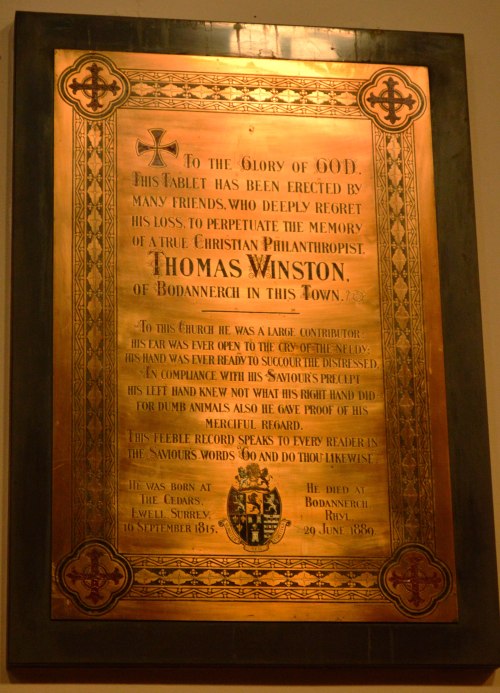The proposed cycleway along the tracks of the old Vale of Clwyd Railway caused great controversy a few years ago, and the plans never came to fruition. There were, of course, arguments on both sides but an opportunity to trace the journey of the old steam trains from Rhyl along the beautiful Vale of Clwyd was lost.

The railway dates back to June 1856 when “The Vale of Cwyd Railway Act” received Royal Assent, this allowed the construction of a line from a junction with the Chester and Holyhead Railway near Rhyl to Denbigh, a distance of 10 miles.
The following extracts are from “The Railway Magazine”, February 1957, where J.M. Dunn describes The Vale of Clwyd Railway.
The first directors were all local men. The contractor was David Davies, who undertook to complete the line and to maintain it for 12 months afterwards; Thomas Savin, a mercer of Oswestry, was associated with him in the undertaking.
The first sod was cut on August 7th, 1857, just over a year after the act had been obtained, but once the work was put in hand it proceeded vigorously and it is said that the period of the construction of this line was one of the most strenuous in David Davies’s life. The line was not difficult to build, but the job had to be done quickly and he is said to have worked 16 hours a day regularly, often getting what sleep he had in the firebox of a “dead” locomotive! The line opened on October 5th 1858, only 14 months after the first sod was cut. Only a single track was laid, but the works were built to take a double line should this later be found necessary; it never was.
Alan Fletcher describes the occasion of the first train from Denbigh to Rhyl, in “The Clwyd Historian”, October 1988:
The day was set fair. It was a fine autumn morning when at 6 o’clock the Russian gun at Denbigh Castle thundered out the signal for the festivities to commence…… Considering that the Vale of Clwyd Railway was really only a minor appendage to the Chester to Holyhead line as far as Rhyl was concerned, the seaside resort made a splendid effort to welcome the branch line. There was great excitement, the town was decorated with flags and at Queen Street by the “George” there was an arch of evergreens constructed by a Mr Healing.
In his article, J.M. Dunn continues:
Another Act, which received Royal Assent on June 30th, 1862, authorised the construction of a branch 1.25 miles in length to the north-west shore of the estuary of the River Clwyd at Foryd. The branch at Foryd appears to have been opened in October 1865, but this is by no means certain and a great deal of mystery surrounds its early days. Examination of the Parliamentary plans deposited in 1859 shows a line on the course of the present branch from its junction with the Vale of Clwyd main line to a point just north of the bridge by which it passes under the Chester and Holyhead Railway. It then curves to the east, crosses the River Clwyd and continues in an east-south-easterly direction to the Chester and Holyhead station at Rhyl, cutting diagonally across what is now the Marine Lake.
The most intriguing feature of this plan, however, is the fact that from the point at which the projected line leaves the course of the existing branch another line shown as “H.R. Hughes’s Railway” follows the course of the present line to its terminus at Foryd Pier. Further, an official L.N.W.R. list of bridges and other structures dated December 1874, describes the bridge over the Foryd Pier line as “Hughes’s Bridge”. The said H.R. Hughes resided at Kinmel Hall, was a large landowner in the district, and Trustee of the Rhuddlan Marsh Embankment and Commissioner of Her Majesty’s Woods, Forests and Land Revenue, but no details about his railway appear to have survived.
The ballast used for the Vale of Clwyd Railway was shingle obtained from the beach near the Foryd – the spot can still be seen easily today at the end of the line at the pier – and it is known that the L.N.W.R. lent a “Crewe Goods” engine together with a Crewe driver named Clough to the Vale of Clwyd for working ballast trains during the construction of the line. A passenger station was built at the level crossing over the main coast road at Foryd Pier, but there appears to be no evidence that it was ever used as such, although it was stated on August 27th 1864, that the branch would shortly be opened for passenger traffic. The remains of the platform are still to be seen and the station buildings are now a dwelling house called “Pier Cottage”. There was also a station called Foryd on the main Vale of Clwyd line, at the other end of the branch, but this was closed on April 20th, 1885, and is now a place of residence. Foryd Station on the Chester-Holyhead line was opened on April 20th, 1885; it was closed on January 5th 1931.

On September 19th, 1955, the passenger service between Rhyl and Denbigh was withdrawn, although the line remains open for goods and special excursion trains. On Sunday, September 2nd 1956, the signal boxes at Rhuddlan, St. Asaph, and Trefnant, together with all the signals worked from them, were taken away and during the following week the down loops at St. Asaph and Trefnant were removed.
These extracts are from lengthy articles from “The Railway Magazine” and include full details of the line as far as Corwen. If anyone has an interest and would like to see the articles in their entirety please contact the Club.
Take a look at all the stations on the line from Corwen to Rhyl on this wonderful youtube video:
http://www.youtube.com/watch?v=yMcdR2cnwyQ














